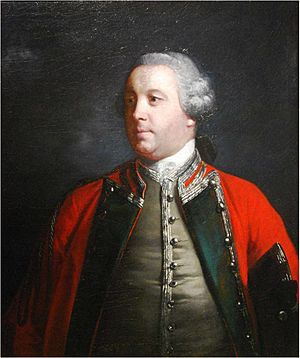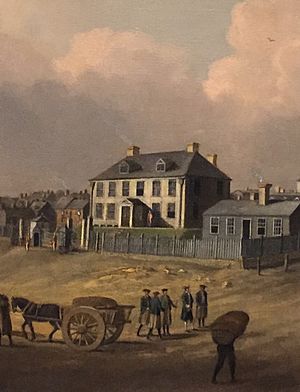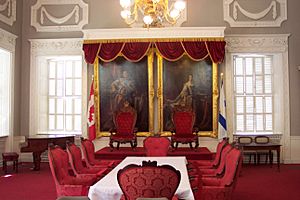Edward Cornwallis facts for kids
Quick facts for kids
Edward Cornwallis
|
|
|---|---|

Edward Cornwallis by Joshua Reynolds (1756)
|
|
| Governor of Nova Scotia | |
| In office 1749–1752 |
|
| Monarch | George II |
| Preceded by | Richard Philipps |
| Succeeded by | Peregrine Hopson |
| Governor of Gibraltar | |
| In office 14 June 1761 – 1 January 1776 |
|
| Monarch | George II |
| Preceded by | Earl of Home |
| Succeeded by | Baron Heathfield |
| Personal details | |
| Born | 5 March 1713 London, England |
| Died | 14 January 1776 (aged 62) Gibraltar |
| Resting place | Culford |
| Spouse | Mary Townshend |
| Relations | Charles Cornwallis, 3rd Baron Cornwallis (grandfather) Richard Butler, 1st Earl of Arran (grandfather) Charles Cornwallis, 4th Baron Cornwallis (father) Charles Cornwallis, 1st Marquess Cornwallis (nephew) James Cornwallis, 4th Earl Cornwallis (nephew) William Cornwallis (nephew) Frederick Cornwallis (brother) Stephen Cornwallis (brother) Charles Cornwallis, 1st Earl Cornwallis (brother) |
| Parent | |
| Military service | |
| Allegiance | |
| Branch/service | British Army |
| Years of service | 1730s–1776 |
| Rank | Lieutenant General |
| Unit | 8th Foot |
| Commands | 20th Foot, 40th Foot, 24th Foot |
| Battles/wars | War of the Austrian Succession Father Le Loutre's War Seven Years' War |
Edward Cornwallis (born March 5, 1713 – died January 14, 1776) was a British army officer. He came from an important family. He became a high-ranking officer called a Lieutenant General. After helping to stop a rebellion in Scotland, he worked for King George II.
Later, he became the Governor of Nova Scotia from 1749 to 1752. Nova Scotia was a British colony in North America. His job was to create a new town there, which became Halifax.
When Cornwallis arrived in Nova Scotia, there was conflict with the local Mi'kmaq people. The Mi'kmaq did not want the British to build Halifax. They carried out attacks on the new settlement. Cornwallis responded with orders to deal with those he saw as rebels. He also built forts and organized a local army. The conflict continued even after he left Nova Scotia.
Despite the fighting, Cornwallis's government set up the first British law courts in Canada. It also created a public school for orphans. His government welcomed different religions. It brought European immigrants to Halifax. This led to the first Jewish and German communities in Canada.
Today, Cornwallis is remembered in Nova Scotia through names of places. However, this has become controversial. This is because of his actions during the conflict with the Mi'kmaq. A statue of Cornwallis in Halifax was removed. A church and a school have also changed their names. The city of Halifax is discussing how Cornwallis should be remembered.
Contents
Early Life and Family
Edward Cornwallis was born into an important family. His grandfather was Charles Cornwallis, 3rd Baron Cornwallis. He was a top official in the British navy. His other grandfather was Richard Butler, 1st Earl of Arran. He was a Governor of Ireland.
Edward's father was Charles Cornwallis, 4th Baron Cornwallis. His mother was Lady Charlotte Butler. The Cornwallis family owned large estates in England. Edward had several nephews who became famous. These included Charles Cornwallis, 1st Marquess Cornwallis, a well-known general.
Edward and his twin brother, Frederick Cornwallis, became royal pages at age 12. They both went to Eton at 14. Their older brother, Stephen, also became a major-general in the army.
At first, it was not clear which twin would join the church and which would join the military. Frederick had an injury that affected his arm. So, he chose a religious path. At age 18, in 1731, Edward joined the army as an officer. He was part of the 47th Regiment of Foot.
Military Service
Edward Cornwallis fought in several important wars. He was part of the War of the Austrian Succession. In one battle, the Battle of Fontenoy, he took command of his regiment. He led a difficult retreat after many soldiers were lost.
Cornwallis also helped stop the Jacobite rising of 1745 in Scotland. After a major battle, he led soldiers to control the Scottish Highlands. His orders were to destroy crops and food. This was to stop the rebels from getting supplies. Some soldiers went against his orders and harmed people.
In 1747, Cornwallis began working for King George II. He served in the royal household for many years.
Governor of Nova Scotia
Building Halifax

The British government chose Cornwallis to be the Governor of Nova Scotia. His main job was to create a new British settlement. This settlement would help balance the French presence at Louisbourg. Governors at this time were often senior military officers.
Cornwallis sailed from England on May 14, 1749. He led an expedition of 15 ships. These ships carried about 2,500 settlers. They arrived at Chebucto Harbour on June 21, 1749. The journey was very well planned. Only one person died during the trip. This was unusual for long sea voyages back then.
Cornwallis had to decide where to build the new town. Some people suggested Point Pleasant. Others wanted the town further inside the harbour. Cornwallis chose the site of present-day Downtown Halifax. It had deep water and was protected by a hill, now known as Citadel Hill.
By July 24, the town plans were ready. In August, settlers were given their plots of land. The new settlement was named "Halifax." It was named after Lord Halifax. He was a key person in the British government.
Conflict with the Mi'kmaq

When Cornwallis arrived, there had been conflicts for many years. The Mi'kmaq people had sometimes attacked British settlements. These attacks often happened with the help of French colonists. Both sides sometimes took people as prisoners.
Cornwallis wanted to renew peace agreements with the Mi'kmaq. He met with some Mi'kmaq leaders in the summer of 1749. They agreed to stop fighting. They signed a new version of an older treaty. However, most Mi'kmaq leaders in Nova Scotia did not sign this treaty. They remained loyal to the French King.
Mi'kmaq leaders met in September 1749. They sent a letter to Cornwallis. They made it clear they did not want the British to settle in Halifax. They said the land belonged to them. They saw the Halifax settlement as "a great theft."
Cornwallis tried to show British power in Nova Scotia. He built forts in important Acadian communities. These included Fort Edward at Windsor. The French also built forts nearby. Fighting began when Acadians and Mi'kmaq attacked British settlements.
To stop these attacks, Cornwallis issued a proclamation. This order aimed to remove the Mi'kmaq from Nova Scotia. It offered a reward for capturing or harming Mi'kmaq men. Later, rewards were offered for women and children too. Despite this, the attacks on British settlements continued.

In May 1751, the Mi'kmaq launched their biggest attack on British settlers. This was the Raid on Dartmouth. After this, the Mi'kmaq stopped their attacks. Cornwallis thought this meant they wanted peace. He helped set up the Treaty of 1752. However, most Mi'kmaq leaders did not accept this treaty.
Cornwallis reported to the British Board of Trade. The Board was often worried about him spending too much money. Cornwallis argued that building Halifax was very difficult. He said it was hard to do under such hostile conditions.
Cornwallis left Nova Scotia in October 1752. This was three years before the end of the conflict. He was then elected to the British Parliament.
Seven Years' War

In 1756, Cornwallis was sent to Menorca. This island was under attack by the French. The British admiral, John Byng, decided to retreat. Cornwallis and other officers were arrested when they returned to England. People were angry about the retreat.
The officers faced a military trial. Cornwallis said he had not disobeyed orders. He said it was too hard to land at Menorca. He also said he was following the admiral's command. Cornwallis was found innocent. The court decided he was just a passenger under the admiral's control.
Cornwallis also took part in a failed attack on the French coast in 1757. This was the Raid on Rochefort. The British forces gathered to attack Rochefort. But the general in charge, Sir John Mordaunt, decided the French defenses were too strong.
Mordaunt held a meeting with his officers. Cornwallis voted to retreat. The mission was called off. Mordaunt was later arrested and tried. Cornwallis testified that attacking Rochefort would have been "dangerous, almost impossible and madness."
Governor of Gibraltar
Cornwallis served as the Governor of Gibraltar from June 14, 1761, until he died. He passed away on January 14, 1776, at age 63. His body was returned to England. He was buried at Culford Parish Church.
Personal Life
In 1763, Cornwallis married Mary Townshend. She was the daughter of Charles Townshend, 2nd Viscount Townshend. Mary was also the niece of Robert Walpole, a very important British politician. Edward and Mary did not have any children.
His brother, Charles Cornwallis, 1st Earl Cornwallis, married Mary's half-sister. This made Edward the uncle of Charles Cornwallis, 1st Marquess Cornwallis.
Images for kids
-
Edward Cornwallis by Joshua Reynolds (1756)
-
Cornwallis built Governor's House (1749). (Province House was later also built on this site and it is furnished still with his Nova Scotia Council table.)
-
The table first used by Edward Cornwallis and the Nova Scotia Council (1749), The Red Chamber of Province House
-
Fort Edward, named after Edward Cornwallis
-
Edward Cornwallis, etching of John Giles Eccardt portrait







